![]()
Febr. 08, 2015
Originally published by The Meir Amit Intelligence and Terrorism Information Center. After about four months of fighting ISIS was defeated in the Kurdish city of Kobanî (Ayn al-Arab) in northern Syria. It was the worst blow dealt to ISIS since the beginning of the American and coalition campaign against it. Since the Kurdish People’s Protection Units (YPG) recaptured Kobanî on January 26, Kurdish forces are continuing to advance in the countryside of Kobanî. Out of the 350 villages surrounding the town, the YPG reclaimed 50 of those villages from ISIS. For an overall analysis of ISIS, examining the nature of ISIS, read ISIS: Portrait of a Jihadi Terrorist Organization.
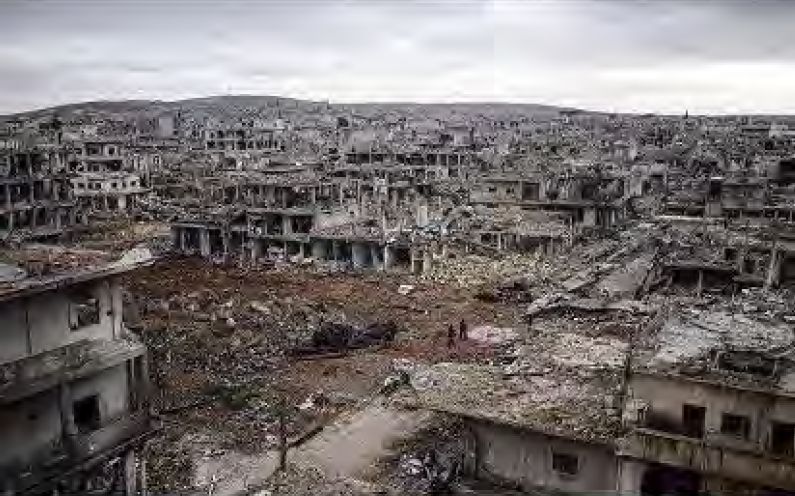
The ruins of the city of Kobanî (Ayn al-Arab) after about four months of fighting (Ayn al-Arab Twitter account, February 2, 2015).
Overview
On January 30, 2015, ISIS issued a video in which it admitted, for the first time, that its fighters had retreated from Kobanî (Ayn al-Arab) in northern Syria, and that control of the city had been retaken by the Kurdish forces. Two operatives who fought in Kobanî admitted that ISIS forces had retreated from the city. They claimed (for propaganda reasons) it was not a defeat in the campaign but rather a retreat carried out because of the coalition force airstrikes (Aamaq News Agency, January 31, 2015). According to media reports ISIS began retreating from dozens of villages in the rural area surrounding Kobanî it had taken control of in the summer of 2014. The coalition airstrikes on ISIS targets in the region continue.
The ISIS campaign on Kobanî’s surroundings began in the middle of September 2014. In order to take over the city ISIS concentrated a force of several thousand operatives with tank and artillery support. During the first stage ISIS took control of the rural region around the city. During the second stage (which began on October 7, 2014) ISIS forces succeeded in entering the city itself and took control of the eastern and southern suburbs. In the three following months fierce fighting developed in Kobanî, during which ISIS met with determined resistance from the Kurdish People’s Protection Units (YPG), which had aerial and logistic support from the United States and the international coalition.

ISIS operative, one of two who appeared in the video and admitted ISIS had retreated from Kobanî (Aamaq News Agency, January 31, 2015)
It was ISIS’s worst defeat since the American-led international coalition forces began the campaign declared by President Obama on September 10, 2014. The main cause of the defeat was ISIS’s difficulty in sustaining extended fighting in an urban setting against trained, highly-motivated Kurdish forces who were intimately familiar with the terrain and determined to defend it. The intensive American and coalition airstrikes also contributed greatly, but ISIS’s claim that the aerial attacks were the cause of its defeat in Kobanî is incorrect and intended to minimize the significance of the Kurdish forces and provide an excuse for the defeat. However, ISIS’s well-oiled propaganda machine has kept a low profile regarding Kobanî while it diverts attention to recent events elsewhere (the executions of the Japanese hostages and the immolation of the Jordanian pilot).
The months of fighting turned Kobanî into a symbol, thus ISIS’s failure, after it had fostered an image of invincibility, is a severe blow to its prestige. Moreover, ISIS’s failure at Kobanî may have the following implications:
- ISIS failed its attempt to enforce its control over a wide swath of hundreds of kilometers along the Syrian-Turkish border, where three international border crossings are located (See map): Tel Abiad (under ISIS control), Jarabulus (under ISIS control) and Kobanî (controlled by both, currently under the control of the Kurdish forces). The victory can make it easier for the Syrian Kurdish forces (YPG) to preserve their connection with the Kurds in Turkey (PKK) and also possibly with the Peshmerga forces in Iraq (although the Turkish authorities can be expected to make such connections difficult to maintain).

The border crossings between Turkey and Syria, from east to west: Qamishli, Ras al-Ayn, Tel Abiad, Ayn al-Arab, Jarabulus, Bab al-Salameh, Bab al-Hawa and Kasab (Assifir.com). Tel Abiad and Jarabulus (controlled by ISIS) and Kobanî (Ayn al-Arab) (currently controlled by the Kurds) are circled in red.
- The victory at Kobanî is a practical and morale-raising achievement for the Kurdish forces in Syria (YPG). It may encourage the separatist aspirations of the Syrian Kurds living mainly in northern and eastern Syria, and strengthen their resolve to establish an autonomous Syrian Kurdistan. It can also raise the morale of the Kurds in Iraq fighting against ISIS. Thus it can be expected that the confrontations will become more intense between the YPG and ISIS in the areas where ISIS control interfaces with local Kurdish control in northern and eastern Syria (ISIS will probably seek to retaliate against the Kurds for the defeat suffered in Kobanî, and in the future may try to retake the city).
- ISIS’s failure to maintain control of Kobanî may have influence on other areas of conflict in Syria and Iraq where the coalition forces have successfully halted the momentum of ISIS attacks. The end of the Kobanî campaign will make it possible for the American and other coalition air forces to divert their efforts to other focal points of conflict and of ISIS control in Syria. Thus it can be assumed that ISIS’s many enemies in Syria and Iraq will be encouraged by the defeat in Kobanî and try to gain territorial control over other regions of battle. On the other hand, ISIS may try to concentrate on locations where it has identified its enemies’ weak spots to restore its damaged prestige and compensate for the defeat in Kobanî (following its retreat from Kobanî, ISIS now has available forces).
An important lesson learned from ISIS’s failure in Kobanî is that airstrikes, regardless of how intensive they are, are not enough to win a campaign.[1] In the case of Kobanî, the combination of the high combat capabilities and determination of the Kurdish forces defending the city, along with the aerial and logistic support of the coalition, were what led to ISIS’s first defeat of such significance (as opposed to ISIS’s other successes, including the continuation of the flow of foreign fighters from and terrorist attacks in Western countries). The lesson learned about the need for skilled ground fighters in Kobanî is relevant to other areas in Syria and Iraq where the international coalition is fighting ISIS.
For the chain of events at Kobanî and the results, see the Appendix.
![]()
Appendix
The Campaign for Kobanî (Ayn al-Arab) — Initial Summary
Overview
Kobanî (in Kurdish) or Ayn al-Arab (in Arabic) is a Kurdish city lying east of Jarabulus near the Syrian-Turkish border. Before the fighting began 200,000 people lived in the city and surrounding villages. Almost all of them have fled, most of them to Turkey. Since the summer of 2014 Kobanî has become a symbol of the struggle waged by the Kurds and the international coalition against ISIS. It began in the wake of ISIS’s military initiative to take over the city and its rural surroundings in order to establish its rule in northern Syria and control the area to the Turkish border.
The city of Kobanî was defended by a Kurdish military force of the YPG, the People’s Protection Units. The YPG is the military-militia force of Kurds who live in northern and eastern Syria, especially in the al-Hasakeh, Aleppo and al-Raqqa provinces. The Kurds, who make up approximately 10% of the Syrian population, also exploited the vacuum created by the disintegration of the Syrian regime to strengthen themselves militarily and to establish an autonomous administration for the Kurdish population. That put the Kurds on a course of direct conflict with ISIS, which is hostile to them as well as to other minorities in Syria. During the past year, ISIS enlarged and entrenched itself in the area of its self-declared “Islamic State” in northern and eastern Syria.
In July 2014 ISIS forces began attacking Kobanî and the Kurdish villages in the rural area surrounding it. ISIS concentrated a force estimated at several thousand operatives in the region. The Kurdish forces were also estimated at several thousand (some of them women). During the first stage the ISIS forces, with tank and artillery support, took control of the villages surrounding Kobanî and imposed a blockade. During the second stage, which began on October 7, 2014, ISIS forces entered the city itself.
ISIS operatives took control of the Kobanî’s eastern and southern suburbs and engaged in street fighting with the Kurdish forces to extend their control and expel the Kurds from the city. In street fighting which sometimes took place in harsh weather conditions the Kurdish forces halted ISIS’s attack. At the end of 2014 the Kurdish forces gradually retook the captured neighborhoods of Kobanî until they had expelled the ISIS operatives at the end of January 2015.
In the campaign for Kobanî, local Syrian and Iraqi fighters fought in the ranks of ISIS alongside Arab and Western foreign fighters. They used familiar combat tactics, among them artillery fire to pound regions held by the Kurdish forces, sniper fire, suicide bombing attacks and booby-trapped cars and trucks inside the city. The battle was accompanied, as usual, by an ISIS propaganda campaign. ISIS also sent a UAV over Kobanî to collect intelligence.
According to media reports, ISIS announced it had retreated from dozens of the villages it had occupied in the region around Kobanî. The reason, according to Lebanese TV channel Al-Mayadeen, was that without control of Kobanî there was no significance to ISIS’s presence in the surrounding rural area. Another reason was ISIS’s concern that the Kurds would harm their supply lines from al-Raqqa to Kobanî (Al-Mayadeen TV, Lebanon, February 5, 2015). In any event, ISIS’s retreat has not ended and the international coalition forces continue their attacks on ISIS forces in the Kobanî region (as of the beginning of February 2015).

Documenting the use of a booby-trapped truck in Kobanî. Left: The truck detonates. Right: The truck is driven to the target (Al-Platformmedia, January 5, 2015).

Left: Kurdish fighters photographed with the bodies of ISIS operatives killed in battle. Right: ISIS operative fights in Kobanî in the snow (Facebook page affiliated with the Peshmerga in the region of Kobanî, January 16, 2015).
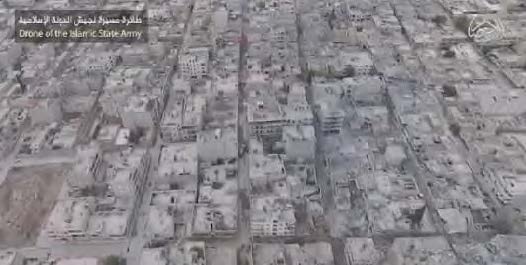
From an ISIS video taken by a UAV on October 27, 2014, in which ISIS claimed it controlled the eastern and southern suburbs of Kobanî (YouTube October 27, 2014; Al-Arabiya TV, October 28, 2015)
American Support
The American-led coalition forces provided air support for the Kurdish forces fighting in Kobanî, diverting the effort to the city at the expense of attacks on other targets in Syria. The coalition forces carried out more than 600 airstrikes during the fighting in Kobanî, out of a total of 900 airstrikes carried out in Syria during that time (i.e., 2/3 of the total number).
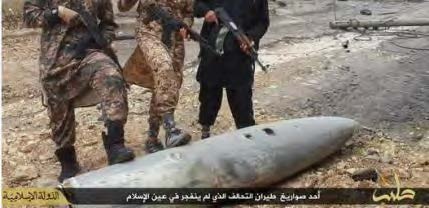
ISIS operatives in Kobanî examine the remains of a missile they clamed was fired by the American-led coalition (From an ISIS-affiliated Twitter account, December 21, 2014).
In addition to aerial support the coalition forces airdropped supplies for the Kurdish forces, including weapons, ammunition and medical supplies. Some of the equipment intended for the Kurds did not fall on target and wound up in the hands of ISIS. However, generally speaking, the logistic support that reached the Kurdish forces in Kobanî (both from the air and overland via Turkey) contributed to their fighting capabilities.
Turkish Support
When the fighting in Kobanî began the Turkish army deployed forces on both sides of the border but did not intervene. Initially Turkey also refused to permit Kurdish reinforcements to reach the city. In ITIC assessment, that was mainly the result of Turkey’s basic desire to avoid direct involvement in the events in Syria, and its fundamental concern that the strengthening of the Kurds in Syria might filter into Turkey and increase the PKK’s separatist aspirations. In addition, Turkey feared it would become a target for ISIS and global jihad terrorist attacks.
During the second half of October 2014 Turkish policy changed, apparently the result of American pressure. At the end of October 2014, for the first time since the beginning of the campaign for Kobanî, Turkey permitted Kurdish Peshmerga forces from Iraq and Free Syrian Army forces from various locations in Syria to pass through its territory to reinforce the YPG Kurdish forces.
On October 28, 2014, 150 Peshmerga reinforcements left Erbil, the autonomous Kurdish capital in Iraq. Some of them flew to Turkey and from there made their way to Kobanî. Others went in an overland convoy, bringing artillery and anti-tank weapons. In addition, the Turks permitted about 150 Free Syrian Army fighters to go to Kobanî from Turkey. The Free Syrian Army fighters crossed the border on October 29, 2014, and joined the Kurdish forces fighting in the city. In ITIC assessment the reinforcements contributed both practically and to the morale of the Kurdish fighters in Kobanî.
What Were the Reasons for ISIS’s Defeat in Kobanî?
In ITIC assessment there were several reasons for the ISIS defeat:
- As opposed to the past, in Kobanî ISIS was faced with well-trained, highly motivated Kurdish fighters who were fighting for their homes and were prepared to fight fiercely to defend their city and the surrounding region. The Kurdish forces were intimately familiar with the terrain and were prepared for street fighting after almost all the city’s inhabitants had fled. The air and logistic support from the American-led coalition forces and the reinforcements that arrived from Iraq and Syria through Turkey also supported the Kurdish forces practically and raised their morale. On the other hand, the coalition airstrikes made it difficult for ISIS operatives to concentrate their efforts on Kobanî and bring reinforcements into the city from other areas.
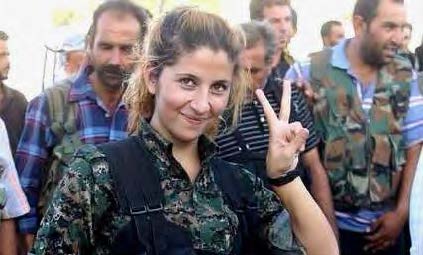
Women also fought in the ranks of the Kurdish fighters (Twitter account of Ayn al-Arab, January 26, 2015).
- It was the first time ISIS operatives were forced to carry out an extended campaign in an urban setting (after its fast, easy victories in Mosul and other locations in Iraq and Syria). Under such conditions, in addition to the ongoing airstrikes, ISIS found it difficult to achieve victory using the methods it had used previously. Those mainly involved concentrating its efforts on short, massive battles exploiting the elements of surprise and mobility. The tactics of suicide bombing attacks and the detonation of car bombs also could not bring them victory in a large city like Kobanî. In Kobanî ISIS was forced to fight according to the enemy’s rules under the enemy’s conditions, leading to defeat.
- As opposed to the Syrian Kurds, who concentrated the bulk of their military effort in Kobanî and its surroundings, at the same time ISIS was fighting other battles in other locations in Syria and Iraq. Therefore ISIS was obliged to divert its forces and allocate weapons and manpower there. In ITIC assessment, in Kobanî there was evidence of the imbalance between ISIS’s limited order of combat (tens of thousands of operatives) and the vast areas in Iraq and Syria where it had to invest its forces, both in ongoing fighting and in establishing civilian governance.
The Results of the Fighting (Updated to the Beginning of February 2015)
On January 26, 2015, the Kurds announced they had liberated Kobanî from ISIS. On January 30, 2015, ISIS issued a video admitting that its forces had retreated from the city because of the coalition airstrikes. The fighting in Kobanî itself has ended, at this stage at least, although there are still ISIS operatives in the surrounding areas. Massoud Barzani, president of the Kurdistan region in Iraq, praised the great achievement and thanked the coalition forces and Turkey for their joint effort in the struggle against ISIS. He said that the news of the liberation of Kobanî was gratifying to all Kurds and all those fighting for freedom (Shafaq News, Iraq, January 27, 2015).
In ITIC assessment, many hundreds of ISIS operatives were killed in the fighting in Kobanî, as were several hundred Kurdish fighters. Al-Marsad Al-Souri, a London-based Syrian human rights organization, reported that 310 Kurdish fighters and 491 ISIS operatives were killed in Kobanî during the last 40 days of the fighting (which was particularly fierce) (Al-Hura, February 5, 2015). Hoshyar Abdallah, a member of the Security and Defense Committee of the Kurdish government in Iraq, reported that ISIS lost more than 800 operatives in the battles in Kobanî (Akhbar al-Iraq, January 27, 2015).[2] The city itself was almost completely destroyed in the fighting.
ISIS has kept a low media profile regarding its defeat in Kobanî, diametrically opposed to its usual post-victory media campaigns. Because of propaganda considerations, it represented the retreat of its forces as the result of the American and coalition airstrikes and minimized the main role played by the Kurdish forces in the battles. The execution of the two Japanese hostages and the immolation of the Jordanian pilot also contributed, as far as ISIS was concerned, to diverting Arab and international attention from its defeat in Kobanî to its daily activities.
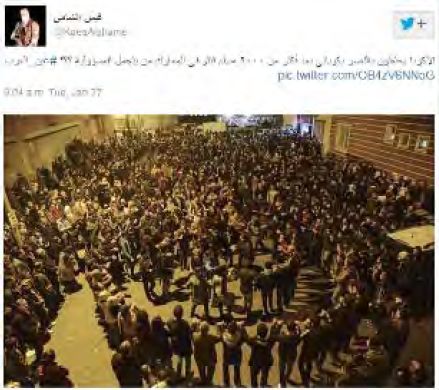
Criticism from ISIS’s rival, the Al-Nusra Front. A Twitter account affiliated with the Al-Nusra Front posted the picture on January 27, 2015, with the heading, “The Kurds celebrate their victory in Kobanî after more than 2,000 Muslims were killed in battle. Who bears the responsibility?”
![]()
Notes:
[1] The coalition forces led by the United States carried out more than six hundred airstrikes in the Kobanî region at the expense of attacking targets in other locations in Syria. They focused on ISIS’s supply lines, its weapons, vehicles and operatives. While they did in fact harm ISIS and make fighting difficult for it, they were not the reason for its defeat, and certainly not the only reason.
[2] Other estimates, which generally seem exaggerated, claim that ISIS lost thousands of operatives in the campaign for Kobanî. A Twitter account affiliated with Islamic sources in Syria opposed to ISIS claim that it lost more than 2,000 operatives in the campaign. Another source reported 3,710 ISIS fatalities since the beginning of the battles (Al-Mukhtasar News Agency, January 30, 2015).



 RSS
RSS

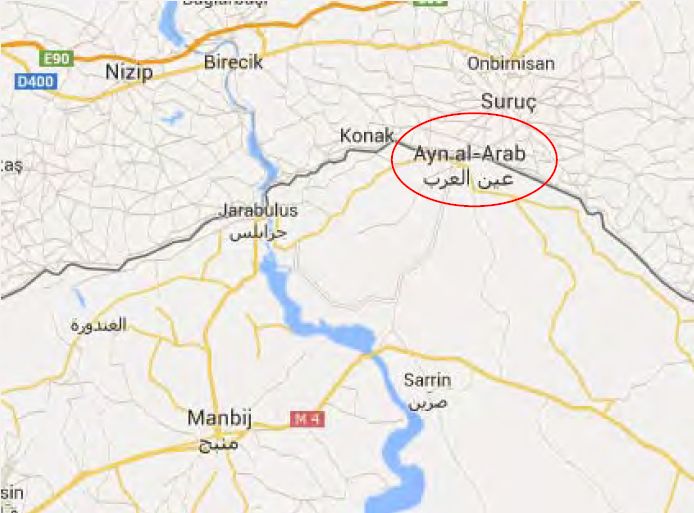

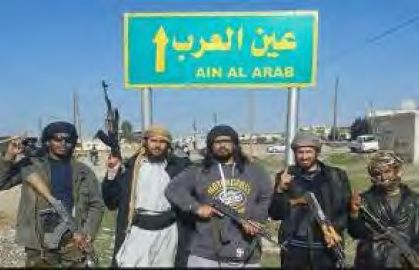
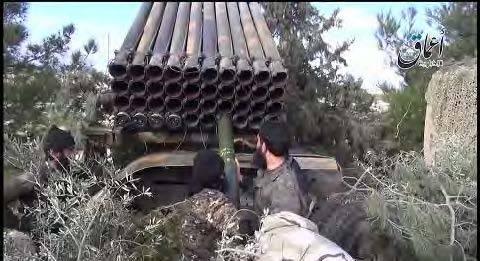
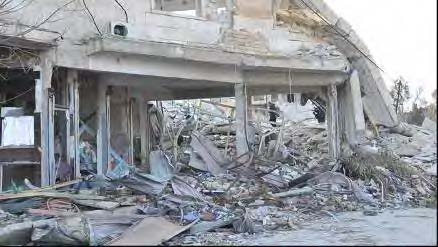



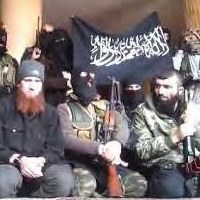






Latest Comments
... [Trackback] [...] Read More: crethiplethi.com/contact-form/trackback/ [...]...
Hello Mike, Thank you for your positive feedback to the article. I felt there wasn’t too much critical analysis of ...
Thanks for this considered and well constructed article. A follow up article on the manner in which the editorial contro...
THE CLUELESSNESS OF CLAIMING THAT OBAMA'S MIDDLE EAST POLICIES WERE A FAILURE CANNOT BE FURTHER FROM THE TRUTH, WHAT THE...
As long as Obama is the president of the usa do not trust the us government......